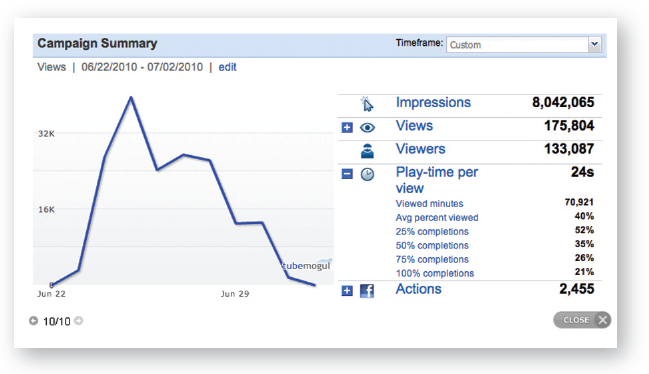Video for 'Net Success - Marketing & Measurement

The first two parts of our Small Business Lab on Web video provided insights into the research, planning, development and production processes involved in launching a successful online video campaign. In this, the third and final installment, we will address the different methods for marketing your videos and measuring their impact on the overall goals of your business.
It would probably be redundant, then, to mention that video is the fastest growing medium in the history of the Web, and that both consumers and marketers are embracing it at unprecedented rates of adoption. Neither, then, is it necessary to point out the fact that small and mediumsized businesses in virtually every industry are currently building their brands, engaging new customers and selling their products and services through the use of online video.
Instead, let's take a look at the multitude of marketing channels and analytics solutions available to online businesses that are considering implementing video. According to the recent Online Video and Media Industry Report from BrightCove and TubeMogul, Facebook now accounts for nearly 12 percent of all referred online video traffic, surpassing Yahoo to place it a distant second behind Google search results - which accounts for 60 percent of all video referral traffic.
What's more, while Twitter produces only about 2 percent of the current referral traffic for video, engagement rates among viewers are higher for Twitter than they are for Google. Viewers referred by Yahoo, meanwhile, had the highest engagement times for brand-produced videos, averaging nearly two-and-a-half minutes apiece.
And we haven't even mentioned by name the Googleowned property known as YouTube, where 70 percent of all online video viewing takes place.
What all this data tells us is that video is a medium that truly blurs the lines between search and social. In order to be successful, businesses have to ensure that their videos are as accessible through standard SEO practices as they are compelling for users to share on social networks. While that may require a delicate touch at times, it is also exactly why video is such a powerful tool for small businesses on the Web.
A properly optimized video marketed to the right channels can change a company's fortunes literally overnight. So, let's look more closely at the three phases of video marketing and measurement.
Optimize
As we discussed in last month's article on video production, the best course of action is to create videos that are extremely relevant to your products, business or industry and to keep them between 30 seconds and five minutes long. This will not only help your SEO efforts but also provide the most value for viewers.
Once production on a video has been completed, however, there are several methods with which you can further optimize the content for search engines. Similar to SEO for text-based content, the process for video begins by targeting relevant keywords. Identify those keywords and use them to create titles, tags, filenames for the videos and the channels on which they reside, meta data, descriptions and anchor text to use when linking videos from sites other than your own.
A video sitemap will create additional opportunities for keyword optimization, and the use of rich snippets and structured data makes all Web content more easily found in searches. Additional data that can be included for videos includes the film's running time, publication date, expiration date, geographic location - any information that will help users not just find your videos but also connect them with your business or brand.
Including the actual HTML transcripts when you post your videos is another form of optimization. Using a shortened transcript on channels other than your own, and adding a link back to your site to read the full transcript is one more useful strategy. Following these guidelines will help your videos rank higher in searches and allow you to move to the next phase of online video marketing.

Analytics solutions from video platforms and providers such as TubeMogul give detailed information about the performance of campaigns, including impressions, views, completion rates, social actions and more.
Socialize
While search is a critical element to the marketing of any type of Web content, video is an inherently social medium that must navigate the social Web to achieve its business goals. That requires that videos be distributed to the channels where the most relevant viewers will find them, and constructed in a manner that compels users to engage in and share them with their friends.
The conversation about video-sharing sites most definitely starts with YouTube, where some 2 billion streams are viewed every day. It is a virtual given that any business getting started in video should take advantage of a YouTube channel, and there are several options. User channels are the free accounts available to anyone who wants to post videos, while YouTube partner channels and brand channels offer deeper functionality and a share of the advertising revenues. The impressions gained by businesses accepted into these channels not only generate revenue but also improve the search rankings of each video on Google.
But YouTube is only the start of the conversation, and businesses should also be sharing their videos on Facebook, Twitter and other sites like Vimeo and Dailymotion - in addition to their own sites, of course. Services such as TubeMogul provide an excellent way of distributing your videos to the most popular sites and in front of the most relevant users, but it will do little good if the videos are not built to last on the social Web.
It is important that each video includes social features such as sections for users to provide comments, ratings and reviews and simple methods for sharing them across their favorite social networks. In addition to being shared and made for others to share, videos should be syndicated and submitted to RSS feeds for maximum exposure, attention from the search engines and potential linking opportunities.
Analyze
No one knows exactly why or how a seemingly ordinary business video such as the recent A Day Made of Glass from Corning Glass goes viral, generating millions of views on YouTube and spreading like wildfire across the social Web. The far more important question for marketers is, "Now what?"
As in everything else in Web business, analytics holds the key to creating success out of a successful execution - or building toward success from a poor execution. Behind every video campaign should be a quantifiable end goal, whether that goal is to build brand awareness, generate advertising revenue, create discussion or sell a product. Only through analytics can a business determine if that goal has been met, and the answer will not always be found in the number of page views a video receives.
Most of the leading online video platforms such as Invodo, BrightCove, TubeMogul, SundaySky and Ooyala offer rich analytics solutions as part of their services, which can be tied in with or separate from their offerings in development and production. YouTube Insights has undergone several recent upgrades to provide deeper analytics for users of its free and partner channels, as has most every other video-sharing site, social network and social media management tool in the past few months alone.
One of the advantages to online video is that because of its unprecedented rise in popularity, the Web is full of companies competing to provide the latest technologies to help brands, marketers and small businesses succeed in the space. It is a category so filled with opportunity today that it's unlike anything we've seen before, and that opportunity should not be missed.










